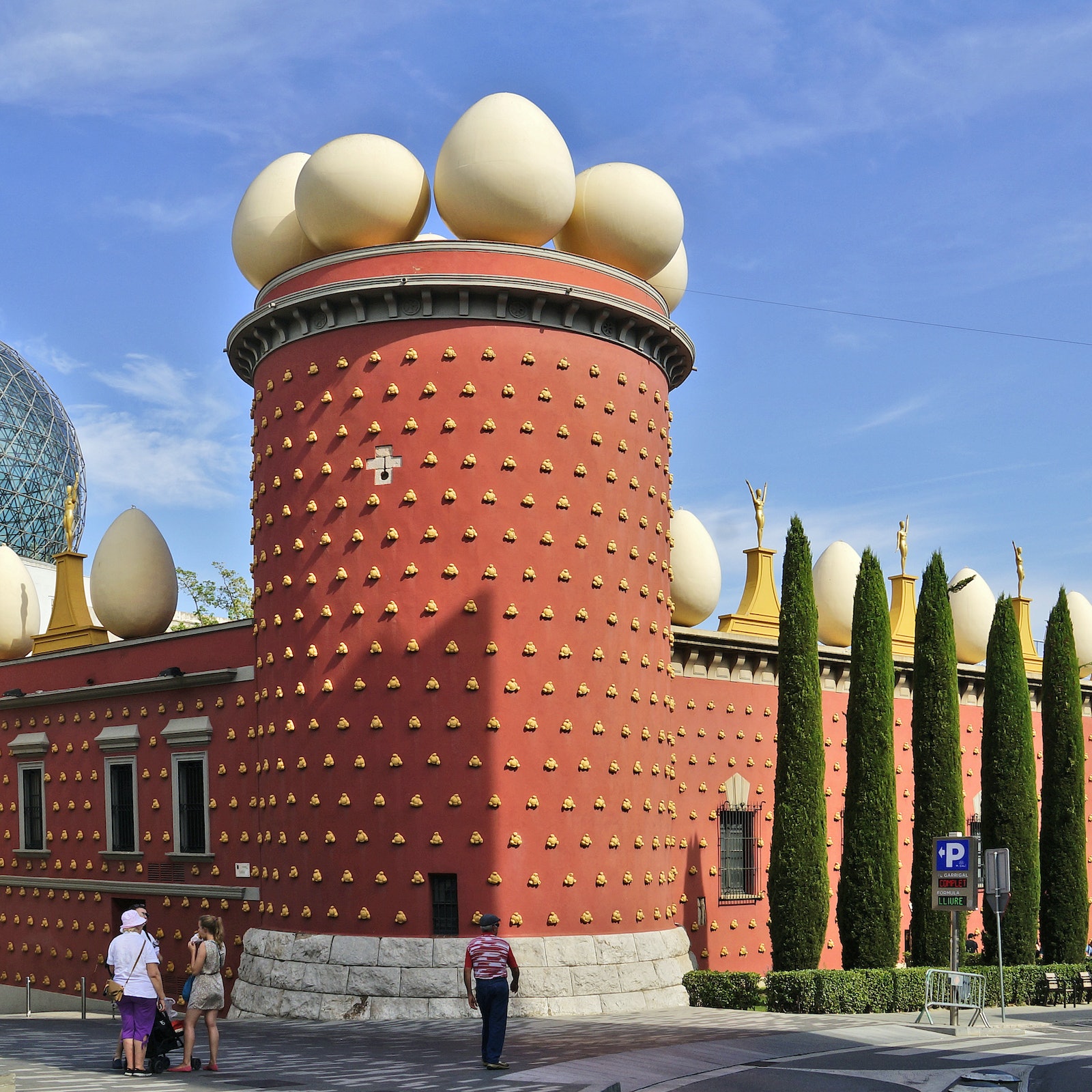
Catalonia is the Spanish region that is the birthplace of Salvador Dalí, one of the most eclectic and innovative artists of the 20th century and the father of Surrealism. Figueres, the town where he was born; Port Lligat, where he lived for more than 30 years; and Púbol, where the castle he gave to his beloved wife Gala is located, make up the so-called ‘Dalí Triangle’. The theatre-museum, the house-museum and the castle were conceived by the artist himself, who lived in all three, and still today they are a concentrate of Surrealist thought and art and a testimony to Dalí’s incredible world.
Dalí Museum in Figueres: tickets and works to see
Dalí’s theatre-museum in Figueres, his home town, was the former municipal theatre, destroyed by fire in 1939 during the Spanish Civil War.
In the museum-theatre Dalí first exhibited his works as a child, when it was still the city’s municipal theatre. In 1961, the artist began work on transforming it into what we see today: the largest Surrealist object in the world, as well as an exhibition space that testifies to his journey from a young non-conformist artist to the father of Surrealism.
In addition to the original theatre space, the Galatea Tower was annexed in 1981, renamed by Dalí in honour of his wife Gala. On the façade of this building we can see two of the symbols of his art: the bread and the egg. In the Galatea Tower Dalí spent the last years of his life (1984 to 1989) and today the exhibitions of the Gala-Salvador Dalí Foundation are held there.
The ticket for the Dalí theatre-museum allows you to skip the queue at the entrance, can be shown by smartphone and also gives access to Dalí’s collection of jewellery, purchased in 1999 by the Owen-Cheatham Foundation and displayed in one of the rooms of the Fonda Condal, which was annexed to the theatre-museum in 1994. In addition to the jewellery, there are also preparatory drawings by the artist. Also in relation to the particular architecture and the nature of the works on display, it is not possible to bring backpacks, umbrellas, prams and large bags: it is better to be organised and bring only what is necessary.
There is also the possibility of combining the ticket with entrance to Dalí’s house-museum, which is located in Port Lligat, about an hour’s drive from Figueres. The house was originally a fisherman’s hut and the artist bought it together with his muse, Gala, in 1930. He lived and worked here from 1951 to 1982. During all these years he continued to expand and modify it, almost as if it were, in his words, “a biological structure”. Outside, in addition to the view of the Bay of Port Lligat, there are sculptures of two giant heads and an egg, one of Dalí’s most recurring symbols, but the house itself reflects the Surrealist current, with all different windows and, inside, blind corridors.
Dalí Museum and Gala Castle
It is also possible to buy a combined entrance ticket to also visit the Gala Castle, located in Púbol, another town in Catalonia. The ticket, in addition to admission to the theatre-museum in Figueres, gives access to the Surrealist house purchased and designed by Dalí for his wife Gala. In his intention, it would have been a cosy home and future burial place for his wife, whose tomb lies here.
In addition to art objects, such as a stuffed horse, elephants with very long legs and decorations in full surrealist style, the Gala-Dalí Castle today houses a collection of the clothes of Dalí’s muse and wife, which could only be accessed, in agreement with her, with her permission.
After the death of his muse, Dalí moved here for a couple of years, until his bedroom caught fire and he settled in the museum-theatre in Figueres.
Discovering Dalí from Barcelona
To visit the places where Dalí lived and worked on the Costa Brava, it is possible to buy a ticket for a tour from Barcelona (free for children under three years old) that will touch on the places of interest for Dalí aficionados, but will also stop at the most representative cities in northern Catalonia.
The starting point is the Estació Barcelona Nord and the tour is as follows:
- 90-minute transfer to Girona
- guided tour of Girona (120 minutes): the city is rich in medieval monuments and has a very well-preserved Jewish quarter
- 45-minute transfer to Figueres
- visit to the Dalí Theatre-Museum and the city
- 120 minutes for the return to Barcelona
Included in the ticket are tours of Girona and the Dalí theatre-museum, which you can enter by skipping the queue; food and drinks are not included. As this is a full-day tour that involves moving around, comfortable clothes and shoes are recommended.
Alternatively, you can buy a pass for the ‘Dalí Triangle’, which includes the theatre-museum in Figueres, the house-museum in Port Lligat and the Gala Castle in Púbol to visit the three most representative locations and attractions of the artist’s life and work on the Costa Brava in Catalonia at an affordable price. However, travel must be organised independently.
In alternativa, si può acquistare un pass per il “Triangolo Dalí”, che comprende il teatro-museo a Figueres, la casa-museo a Port Lligat e il Castello di Gala a Púbol per visitare a un prezzo conveniente le tre località e le tre attrazioni più rappresentative della vita e dell’opera dell’artista sulla Costa Brava, in Catalogna. Gli spostamenti, però, vanno organizzati in autonomia.

